| What
is flyball? |
 |
| Home | Dogs | People | Philosophy | Links | Contact | Flyball? | Achievements |
| Future Tournaments |
What is flyball? Most flyball races are 4-dog relay races. The racing is match racing. In other words, two teams race head-to-head against each other, with the winner of the majority of heats winning the race.
The flyball course is 51 feet from the start/finish line to the box (Figure 1). Each dog runs the 51-foot course, jumping over four hurdles along the way, then the dog hits a spring-loaded box and a tennis ball shoots out (Figure 2). The dog catches the tennis ball, turns around, and retraces its 51-foot path back over the 4 hurdles. The dog must carry the tennis ball over the finish line.
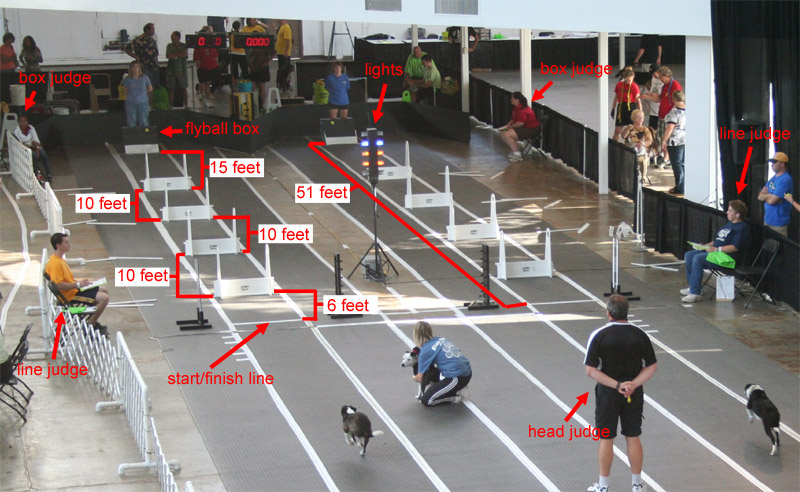 |
| Figure 1. The flyball ring. Each ring consists of two identical lanes, side by side. |
 |
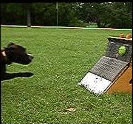 |
| Figure 2. The box turn. As the dog hits the box, a trigger mechanism causes a spring-loaded tennis ball to shoot out. |
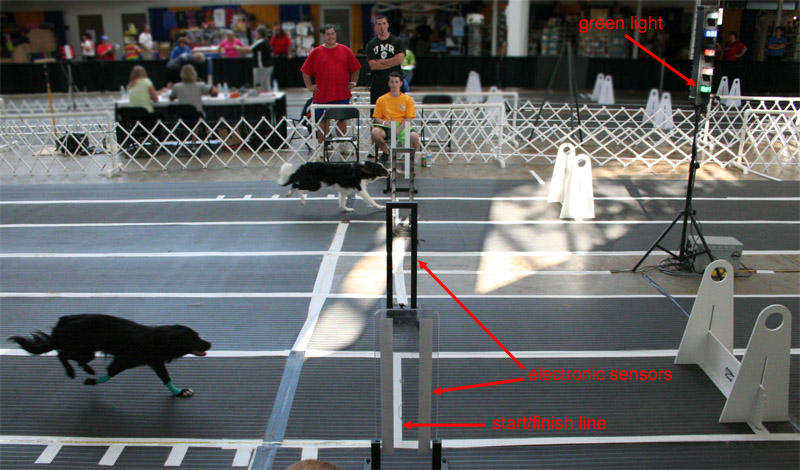 |
| Figure 3. The start dog (the first dog in the lineup). The start lights flash: blue, yellow, yellow, green. The dog can have a running start, but cannot cross the start/finish line before the green starting light flashes. Most handlers release their start dog 50 feet or more behind the start line, when the first yellow light flashes (about 2 seconds before the green light flashes). Electronic sensors detect whether the dog crossed the line early. Skilled starters routinely have their dog cross the start line less than 0.1 second after the green light flashes. Each team is allowed one "free" false start each heat; the heat is simply restarted after the false start. |
The next dog in the relay must not cross the start/finish line before the finishing dog crosses it (Figures 4 & 5). The passing dog is typically released well before the finishing dog has crossed the start/finish line. Although the race is a relay, the dogs do not actually pass the ball between them; a new ball is loaded for each dog (Figure 6).
 |
| Figure
4. A legal pass. The finishing dog has crossed the
start/finish line before the passing dog has. |
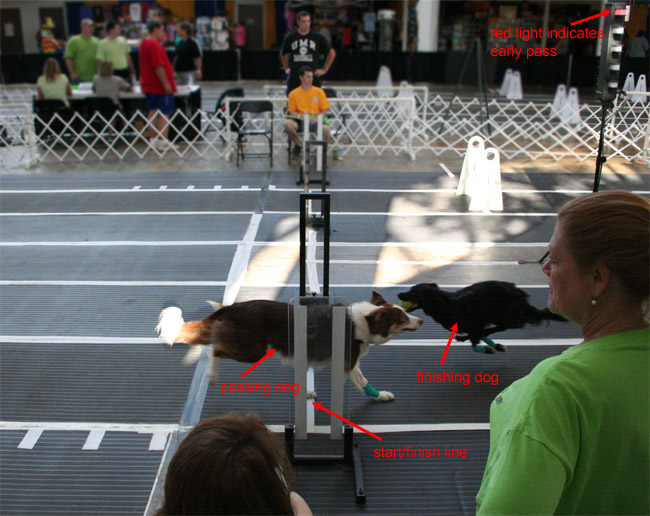 |
| Figure 5. An early pass. The passing dog has crossed the start/finish line before the finishing dog has. The red light indicates that the electronic sensors have detected the early pass. The passing dog will have to re-run after the other dogs in the lineup have run. |
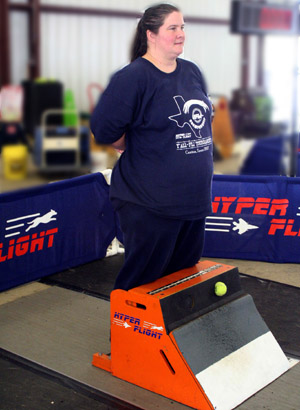 |
Figure 6. The box loader stands on the back of the box, keeping it secure, and loads a new ball for each dog. |
See a video of a flyball heat: link (22-second YouTube video).
If any mistake is made, such as false starting twice, dropping a ball before crossing the finish line, an early pass, or going around hurdles, the dog has to re-run the heat. The re-running dog will run after the other three dogs have finished the heat. Sometimes there are multiple mistakes, so multiple dogs will have to re-run in the order in which their mistakes were made.
When all four dogs have completed the course, the heat is over. The winner of the majority of heats wins the race (a race typically consists of three to five heats).
The height of the hurdles varies from 6 to 12 inches. The hurdle height is determined by the arm length of the smallest dog on each team. The smallest dog is often referred to as the "height dog." Very often, two teams that are racing each other will be jumping different height hurdles, because they have height dogs of different sizes.
Flyball is split into divisions by time. Therefore the fastest teams, which race in division 1, race each other, and slower teams (divisions 2, 3, 4, etc) race each other. That’s one of the great things about the sport–regardless of how fast or slow a dog is, it can still be competitive in its division. Dogs of virtually all breeds and people of all ages play flyball.
Each dog typically has one human handler. The handlers are as involved in the racing as the dogs are. The handlers release the dogs, ensuring good starts and passes. Additionally, the handlers are the dogs' motivation to run quickly back across the finish line. Once the dog catches the ball, its handler typically runs away from the dog with a tug-toy to get the dog to run back fast. When the dog catches the handler, they play tug for the dog's reward.
In addition to racing to win, many competitors race to earn points for their dogs toward titles. For an explanation of points and titles, see p. 25 of the U-FLI rulebook.
There are several governing bodies for flyball throughout the world. Hyper Flight races only in United Flyball League International (U-FLI) sanctioned events.
Two great videos that show some of the craziness of flyball:
link (3-min, 40-sec YouTube video)
link (2-min, 26-sec YouTube video)